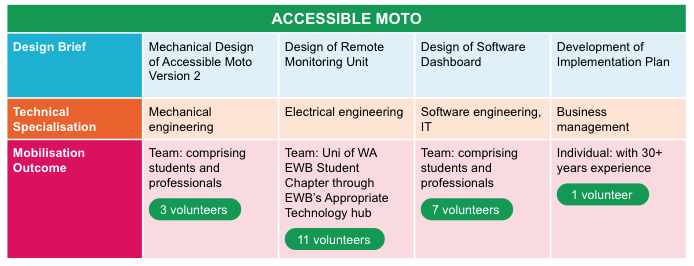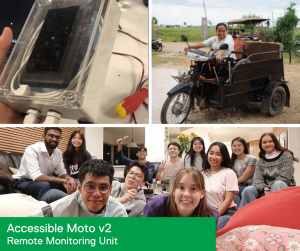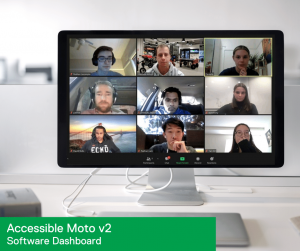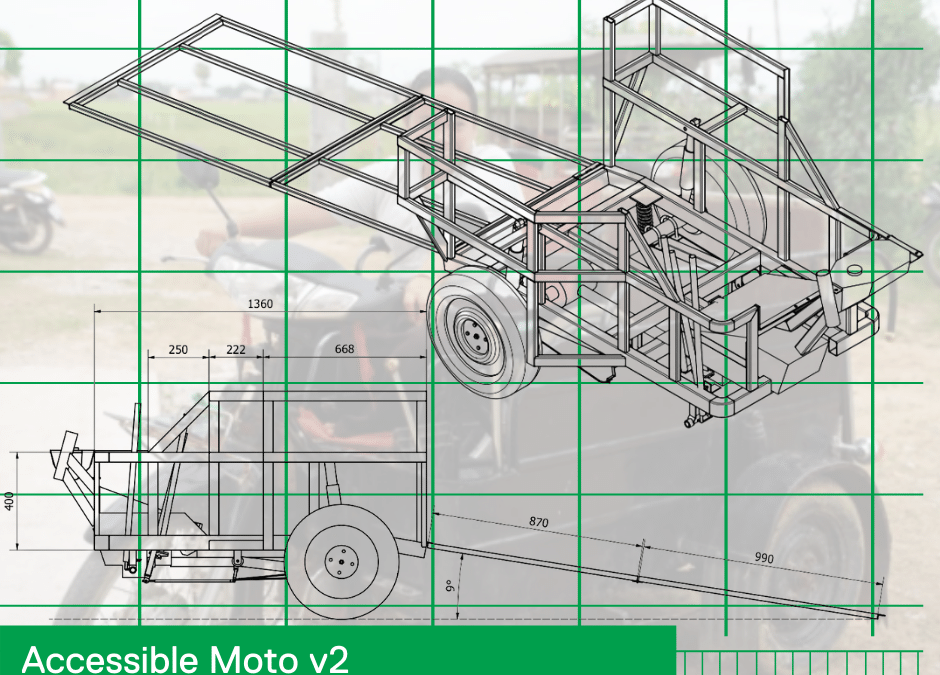Over the past year as EWB Australia initiated its new mobilisation program which matches volunteers with specific real-world projects to support EWB’s work. To launch the program, we identified three distinct streams:
- Open Challenges – such as the BirthWatch project
- Project Initiation – such as the Vehicle Washdown Station
- Technical Specialisation – such as the Accessible Moto v2
The Technical Specialisation mechanism requires individuals with specific technical knowledge to work solo or in teams. They work directly with the EWB Technology Development team, and contribute to the technical aspects of a project. The first project under the Technical Specialisation mechanism aims to support the next phase of the Accessible Moto project.
The Accessible Moto aims to enable better access to independent transport for those who are already using a wheelchair. An initial design and prototype had already been created by the disability-focused organisation Light For The World (LFTW) and community, with no engineering input. In 2019 and with this solid proof of concept, the EWB Technology Development team, based in Cambodia at the time, worked extensively with LFTW and the community via the AgriLab to further develop this assistive technology.
The project was then ready for the next phase. To support this work, a mobilisation project team structure was identified, featuring four different design briefs, building on the earlier work undertaken. Across these design briefs, 22 volunteers were recruited – spanning university undergraduates right through to highly experienced technical professionals – to address the mechanical, electrical, IT and software, and business strategy requirements of this next phase.

The configuration of mobilisation to engage technical specialists to work on Accessible Moto v2
Brief 1: Mechanical Design

Concept drawings for the mechanical design
The mechanical design consists of an accessible, affordable and adaptable motorbike modification that enables rural wheelchair users to access independent mobility. For our users this means trips to the Pagoda, shopping at the market, visiting relatives and getting to and from work independently. Our team has taken the original locally-conceived prototype and incorporated both technical and user insights to co-create a safer, more usable and affordable design.
This part of the design project has been quite challenging, requiring the team to reach deep into the humanitarian engineering toolkit. The aim is to create something that is adaptable to users with various levels of ability, yet simple enough to manufacture and service, and be financially feasible for users.
This has required both the in-depth contextual knowledge and coordination of EWB’s Cambodia team, especially Prak Pin, as well as the technical knowledge of the detailed design team including Andy Drain (EWB’s Technology Development Lead) and Angus Mitchell (EWB Australian Volunteer Field Professional in Cambodia) who were both a part of the initial phase of the project with participants in Cambodia before COVID-19 hit. They are joined by the Mechanical Design volunteer team comprising Yow Wai, Chris Tate, Melvin Varghese and Aishwarya Sahu. These members bring a range of skills including project management and drive system design to provide a fresh perspective in reviewing and providing advice on the design of mechanical systems such as the drivetrain.
The design is currently being finalised, and will undergo safety verification before it enters a small pilot of four users in early 2021. Quickly iterating the design with a small group of wheelchair users enables these users to continue to contribute to the design through further additions, changes and iterations.
Brief 2: Remote Monitoring Unit Design

The Remote Monitoring Unit team, a unit prototype, and an Accessible Moto that the unit will be trialled on
The Remote Monitoring Unit design brief was tackled by a team of 13 engineering students from the University of Western Australia. The team were tasked with researching and developing an accelerometer and GPS logger to help assess the efficacy of the Accessible Moto solution.
The resulting design solution consists of an android phone running a custom app designed to transmit data – whilst in the field – to a remote web server through a cellular connection. This is encased in a protective housing to safeguard it from harsh Cambodian conditions.
As with any R&D project, the team have had to overcome challenges thrown their way, which have ranged from the budgetary to the technical. The team also had little experience with programming languages. Henry Chen (the project’s co-coordinator) needed to guide and teach the electrical team these skills throughout the design cycle.
Robert Crew, who shares co-coordination of the project with Henry, is a second-year electrical engineering student and heard about EWB from a School Outreach presentation.
“Joining the EWB Uni Chapter has been the best decision for me. It has allowed me to contribute to real-world impact while gaining a great deal of experience. And it has led to me participating in this project. It has been a true honour to see our team come together and complete the project with smiles on our faces. The greatest moment for me has been seeing our team really pull together to finish this stage of the project after our final exams, and to a standard Henry and I would not have expected in a span of two weeks,” says Robert.
Joining Henry and Robert on the team are Luvha Shrestha, Jamir Izan Khan, Carmen Leong, Kylee Kotula, Cassandra Ly, Jaime Dunn, Kim Lim, Adi Bambang, and Don Benny. The team was brought together initially and led by Laura Tan and Adi Santoso.
Initial testing is underway, with plans for the monitoring unit to be fitted onto an accessible moto and happily transmitting data from Cambodia to EWB HQ by mid-2021.
Brief 3: Design of Software Dashboard

The Software Dashboard team on one of the many remote Zoom meetings
The need for an Accessible Moto was initially identified by Sreymom – an administrator (and wheelchair user) at EWB’s local partner NGO in Cambodia’s Pursat Province. Sreymom found it challenging to travel to and from work, and was heavily reliant on her family and local drivers for transportation. But just how much more freedom will this moto provide Sreymom? How far can she go? How much time will she save? And how does she handle different road conditions? Cue the Software Dashboard design brief!
The project seeks to develop a visualisation dashboard. The system will enable data to be uploaded by each moto by the Remote Monitoring Unit (see earlier in this story), store the data securely (to protect users’ privacy), and allow EWB’s staff Engineering team to easily navigate and see the status of the project. Even though software development and data science are not areas EWB has worked in extensively, engaging our volunteer network has ensured these skills and experience have been injected into the project.
The Software Dashboard team comprises students, recent graduates, consultants and company founders, mostly from Sydney. On the team are:
- Patrick Joy, who uses geographic information systems for the clients of his company ThinkTransit Nathan Lecompte, a student (and EWB chapter president) at Macquarie University and part-time front-end software engineer
- Kristina Mahony, from technology consultancy Accenture
- Nathan Lam, from a STEM social enterprise Code Create; and
- Matthew Imhoff, at the Australian Centre for Field Robotics at the University of Sydney (and all-round EWB volunteering legend).
Nathan Lam, who also previously led EWB University of NSW chapter, is relishing the opportunity to use the skills he has learnt over the years to ‘give back’.
“It’s really exciting to see EWB has volunteering opportunities now for software engineers. I am looking forward to working more with this team and exploring more opportunities in the future.”
The team has been gathering requirements from the EWB staff who will be using the dashboard for monitoring and evaluation and reporting on the moto project. The next steps will be to choose which technologies to use to run the servers and front-end for the dashboard. The team hopes that the digital infrastructure that they build today can help EWB understand and communicate its impact for not just the accessible moto but for future projects as well.
Brief 4: Implementation Plan
Once the Accessible Moto mobilisation teams and community partners in Cambodia have completed the development and testing, a plan for deployment will be needed. EWB sought a business management skill set with an understanding of the development context to undertake this brief.
Meet Mitra. Mitra has recently re-engaged with EWB again after a long hiatus. During this time he has been based between San Francisco and Nairobi where he developed Pay-As-You-Go technology for solar. He’s been actively involved with a number of engineering for change organisations, and seeks to volunteer his skills to particular types of projects.
“When I’m looking at a project to contribute to, the question I want an answer to is ‘which problem is it trying to solve’? Is this trying to be a cool learning experience for the volunteers, is it trying to solve mobility for the few that can be supported within the scope of the grants available, or is it designed to tackle a problem at the scale of the problem – which in this case is the lack of mobility of mostly rural, disabled people in Cambodia,” says Mitra.
Solutions are never just technological. They are always embedded in larger human systems, of which the most obvious is financial, and this is a particular consideration for the Accessible Moto project.
In Cambodia, there are about 35,000 mobility-impaired individuals within the provinces that this solution is trying to reach. We know that a person with disability might spend about USD35 per month on taxis. If we build a system, we need to be able to provide a significantly enhanced experience within that budget.
These are the kinds of considerations Mitra is starting to unpack in the initial stages of scoping the feasibilities associated with implementation.
Initial learnings
Shenuka Peiris, EWB’s National Mobilisation Coordinator, says with the establishment of a new function comes a steep learning curve.
“AgriLab projects are a great way to engage the skills and knowledge of the EWB technical network to support real-life community projects. The projects engaged volunteers from across the country, which was exciting. They created a strong collaborative environment within the volunteer teams, and allowed technical volunteers with a wide range of experience to work together,” says Shenuka.
The teams, comprising emerging and established engineers, made for a winning composition. Students have more available time to apply to projects to ensure the work is delivered, and professionals provide experienced insights and feedback. Both students and professionals engaged in valuable mentoring relationships, building the capacity of both cohorts.
Finding the right balance of sufficiently engaging the EWB Engineering and Technology Development teams and creating a supportive yet autonomous environment for the technical teams was also a key learning. The program was set up to operate in a remote and online working environment, but there will be opportunities to improve the systems and processes to provide a great online volunteer experience. The establishment of a Mobilisation Coordination Team – a group of volunteers who support the people responding to the design briefs – was also critical.
Working remotely on a human-centred engineering project comes with many challenges. Despite this, close relationships with EWB’s staff and partners in-country has enabled these teams to progress designs significantly. All of this has enabled EWB to gain the contextual knowledge required to launch a pilot of the new accessible moto design in 2021.
Interested in mobilising?! Sign up to volunteer here!
EWB’s Cambodia Program is supported by the Australian NGO Cooperation Program (ANCP) and generous donors.


